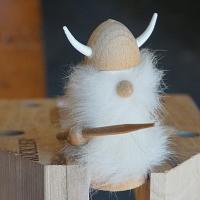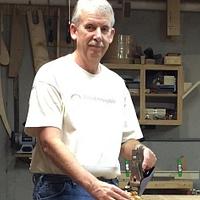
Mike40
in over 11 years
Homemade Liquid (cold) Hide Glue
While planning my first veneer marquetry experience I was a little worried about using hot hide glue to fasten the marquetry to the box sides of my project. I worried that the glue would cool too quickly before I could get it into the veneer press.
I had read an article here about making your own liquid hide glue that could be used at room temperature and which had a very long open time. Realizing that this would eliminate any risk of the glue setting up too quickly before pressing I decided to make some. Another motivation for me was that liquid hide glue is not sold here in Norway and I’m not willing to pay freight for a product that has so much water in it! here’s a pic of my finished product and a drop of it on the veneer to show you what it looks like poured cold.
The formula is really simple as 1,2,3:
1 part table salt
2 parts glue
3 parts water
I applied this formula based on volume. “Here” is the article on the details.
Step 1 Add water to the glue flakes and let it sit overnight.
Step 2 Cook the ingredients at 145F or around 60C for 2 hours, then put it in the fridge while still hot until the next morning.
Step 3 Cook for another 2 hours at 145F and it’s done and ready for use.
My results were good even though I’m not sure if my proportions were absolutely correct. I did some test glue-ups and checked them the next day and they hadn’t set, so I tested again and let it sit for two days, and that one really worked well with the wood tearing out when I tried to part the glue joint. In the end I didn’t want to wait so long for the glue to set so I wound up using hot hide glue instead and it worked out well luckily.
The beauty of this glue is that it doesn’t get outdated because the salt preserves it so well and also keeps it in liquid form and you don’t have to heat up the bottle in order to pour it out either.
My conclusions
I really don’t want to glue up any large marquetries with hot hide glue because I’m not keen on having to use heated aluminium plates to rewarm the glue after getting the glue-up into the press as Paul aka Shipwright does. I’m worried about fire hazard if I were to use a gas flame in my small shop. I could probably heat them in my kitchen oven, but not too practical, especially with our weather in the winter when the plates could cool getting from the house to the shop. I might change my mind about this after awhile, but in the meantime I will have to let the marquetries stay in the press for at least two days if I use my home brewed liquid hide glue.
I plan to make some more liquid hide glue and to be much more precise in following the quantities this time to see if the drying time will be less. I didn’t have a good measuring vessel the first time so I winged it.
I have also learned since from a reliable source that salt can be added to hot hide glue to extend the open time when gluing large panels, but I don’t know how much to add. I think this would be done more economically when most of the glue will be used for the job at hand.
I also found out that mixture of 7% hot hide glue flakes and 93% water make an excellent sanding sealer. I used it on my Chevalet and it work perfectly. A cheap and easy alternative to shellac.
Mike, an American living in Norway
4 Comments
Mike you did not mention when to add the salt and pepper :)
Tor and Odin are the greatest of gods.
The salt can be added after the glue becomes liquid in the pot Madts.
Mike, an American living in Norway
Interesting Mike, I just picked up a bottle of Old Brown a couple days ago. I will have to try this when I run out. Hope to hear more after you have had some experiences using your new brew.
I just finished reading the article you referenced and you post as well.
Very interesting stuff.
Thanks mike
Abbas, Castro Valley, CA











